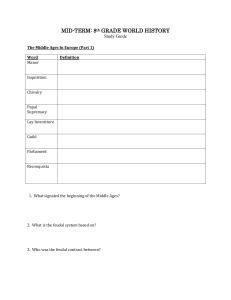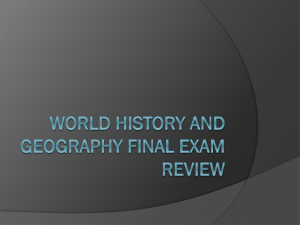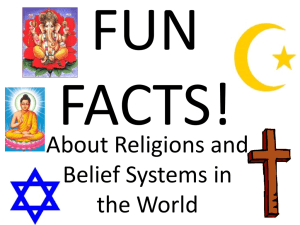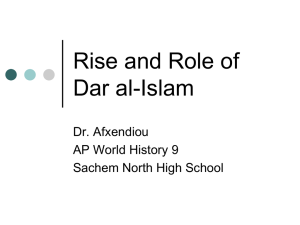AP World History-Islam, Byzantium, Mongols, Africa, and Europe
advertisement
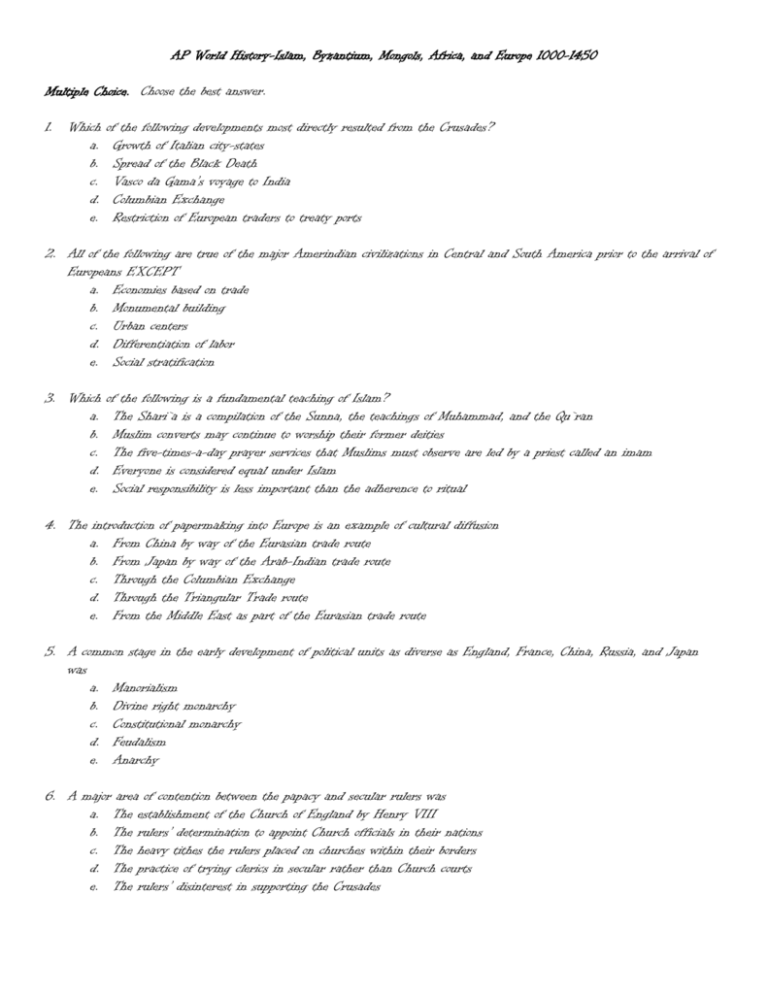
AP World History-Islam, Byzantium, Mongols, Africa, and Europe 1000-1450 Multiple Choice. Choose the best answer. 1. Which a. b. c. d. e. of the following developments most directly resulted from the Crusades? Growth of Italian city-states Spread of the Black Death Vasco da Gama’s voyage to India Columbian Exchange Restriction of European traders to treaty ports 2. All of the following are true of the major Amerindian civilizations in Central and South America prior to the arrival of Europeans EXCEPT a. Economies based on trade b. Monumental building c. Urban centers d. Differentiation of labor e. Social stratification 3. Which a. b. c. d. e. of the following is a fundamental teaching of Islam? The Shari`a is a compilation of the Sunna, the teachings of Muhammad, and the Qu`ran Muslim converts may continue to worship their former deities The five-times-a-day prayer services that Muslims must observe are led by a priest called an imam Everyone is considered equal under Islam Social responsibility is less important than the adherence to ritual 4. The introduction of papermaking into Europe is an example of cultural diffusion a. From China by way of the Eurasian trade route b. From Japan by way of the Arab-Indian trade route c. Through the Columbian Exchange d. Through the Triangular Trade route e. From the Middle East as part of the Eurasian trade route 5. A common stage in the early development of political units as diverse as England, France, China, Russia, and Japan was a. Manorialism b. Divine right monarchy c. Constitutional monarchy d. Feudalism e. Anarchy 6. A major area of contention between the papacy and secular rulers was a. The establishment of the Church of England by Henry VIII b. The rulers’ determination to appoint Church officials in their nations c. The heavy tithes the rulers placed on churches within their borders d. The practice of trying clerics in secular rather than Church courts e. The rulers’ disinterest in supporting the Crusades 7. Which of the following statements most accurately describes the long-term significance of Europe’s economic activity during the High Middle Ages? a. Economic activity in medieval Europe was stagnant b. The roots of European capitalism and entrepreneurial activity were laid during the Middle Ages c. Most Europeans were farmers during the Middle Ages d. European economic activity was fueled by the Eurasian trading network during the Middle Ages e. Manorialism was in decline by the end of the Middle Ages 8. Monasticism was an important aspect of which two of the following religions? a. Islam and Buddhism b. Buddhism and Christianity c. Daoism and Shintoism d. Hinduism and Buddhism e. Christianity and Hinduism 9. Which a. b. c. d. e. of the following statements is accurate regarding feudalism in both Europe and Japan? Feudalism was an economic as well as a political system The nature of feudalism was such that it created a strong central government Feudalism weakened as cities developed Feudalism needed a large agricultural base to support the system The basic feudal relationship was between lord and vassal 10. The empires of West Africa, Ghana, Mali, and Songhai rose to power between the 300s and 1500s a. Because they straddled the main trade route between north and south b. Because of the dominance of Islamic power in the region c. As a result of the establishment of a series of forts by the Portuguese which supported the West Africans against neighboring peoples d. Because the slave trade had not yet become important e. Because the kings centralized government practices so that their subjects had and advantage in the transSahara trade 11. Bantu-speakers settled in all of the following areas of Africa EXCEPT a. West Africa b. East Africa c. Central Africa d. Southern Africa e. South-central Africa 12. Which Ages? a. b. c. d. e. of the following actions had a long-term effect on relations between western and Eastern Europe in the Middle The The The The The invasion of Spain by the Moors acceptance of the Orthodox Church as the official religion of Kievan Russia evolution of feudalism in western Europe crowning of Charlemagne by the pope rise of the Seljuk Turks 13. All of the following were direct results of the Crusades EXCEPT a. The growth of a money economy in Europe b. The growth of European trading centers c. The decline of feudalism d. An increase in the power of the papacy e. Exposure to intellectual and cultural traditions of the Middle East 14. All of the following were unintended results of the Mongol invasions EXCEPT a. The rise of Moscow as the most important city-state in what eventually would become tsarist Russia b. The spread of bubonic plague from China to Europe and the Middle East c. The rise of the Ottoman Turks and the eclipse of the Seljuk Turks d. The collapse of the Byzantine empire e. The adoption of Islam by the Mongols and their assimilation into Turkish culture 15. “It is the imminent peril threatening you and all the faithful, which has brought us hither. From the confines of Jerusalem and the city of Constantinople a horrible tale has gone forth..” The preceding passage was probably spoken about which of the following? a. The creation of the modern state of Israel b. The establishment of the Abbasid dynasty c. The invasion of Europe by the Huns d. The capture of the Holy Land by the Seljuk Turks e. The invasion of the Middle East by the Yuan branch of the Mongols 16. Bedouins were instrumental in spreading which of the following religions? a. Buddhism through China b. Christianity in Africa c. Islam on the Arabian Peninsula d. Presbyterianism in Scotland e. Shintoism throughout Japan 17. Which of the following is NOT an accurate description of why Islam appealed to so many peoples? a. Muhammad, as the last of the great prophets, accepted earlier Judaic and Christian revelation and incorporated them into Islam b. Islam’s Five Pillars provided simple and clear guidance to believers c. Islam was monotheistic and thus shared a common element with Judaism and Christianity at a time when most people practiced polytheism d. Islam preached the equality of all peoples, thus appealing to the poor and oppressed e. Because Islam lacked any legal code, it was possible to adapt Islam to any form of governmental organization 18. Which of the following best describes the East African trading centers prior to the arrival of the Portuguese? a. The trade network to and from the East African coast was fairly local and limited to a small portion of the interior and to nearby coastal islands b. The slave trade was an important element of the economies of the East African trading centers c. Ife was the most important of these east Coast cities d. The cities were a mix of black African and Islamic peoples and culture traits e. The predominant religion was a traditional African-based animism with an overlay of Islamic teachings known as Swahili 19. All of the following modern nations lacked centralized monarchies at the end of the Middle Ages EXCEPT a. Germany b. The Netherlands c. Belgium d. Italy e. Spain 20. Which a. b. c. d. e. of the following were important trading cities along the East Coast of Africa? Kilwa, GAO, and Timbuktu Gao, Great Zimbabwe, and Mogadishu Benin, Gao, and Great Zimbabwe Timbuktu, Gao, and Nok Kilwa, Mogadishu, and Sofala Free Response Questions Choose one question from each of the sections below. Write a brief essay (300-500 words) on each of your choices. Circle the numbers of the questions you are answering. Be sure and make an outline before you begin each of the essays. You will spend the first ten (10) minutes outlining your essay on this sheet (worth one point). When directed to do so, you will be given 30 minutes to write your essay on blank sheets of paper. Remember to use a thesis, unbiased arguments, change over time, supportive facts, specific examples, and a conclusion. Stop and repeat procedures for the second essay. Change over time Questions: 1. Discuss the impact of the Black Death on global societies from 1347to 1450. 2. Evaluate the changing influence and role of religion Africa and Eurasia from 1000-1450. Comparative Questions: 3. The rule of a royal family has been very common in global history. Compare and contrast one of the European monarchies to one of the African empires from 1000-1450. 4. Interregional networks of trade characterized the period 1000-1450. As these trade networks expanded, urban populations grew and major trading centers developed. Describe the part played by trade in the development of trading centers by comparing three of the following urban centers: Cairo Guangzhou (Canton) Samarkand Timbuktu Venice Constantinople
